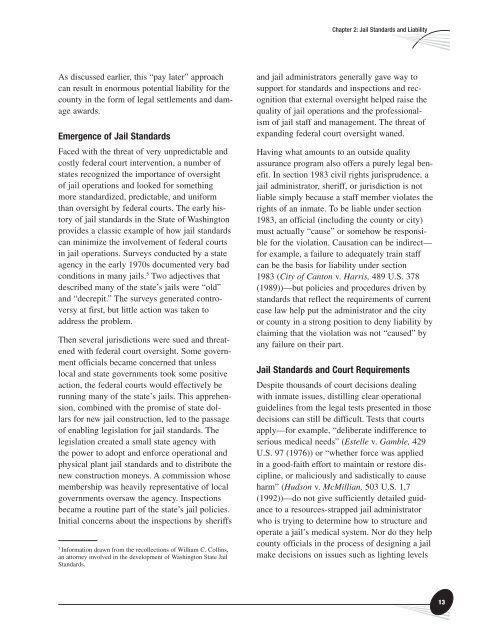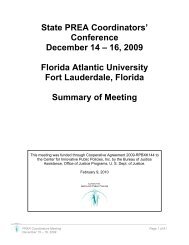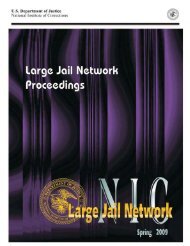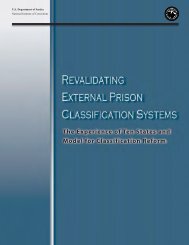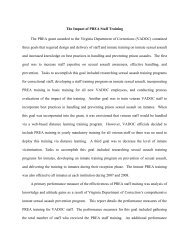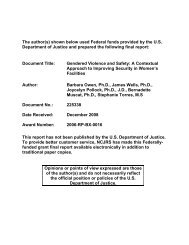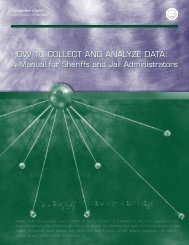Jail Standards and Inspection Programs, Resource - National ...
Jail Standards and Inspection Programs, Resource - National ...
Jail Standards and Inspection Programs, Resource - National ...
Create successful ePaper yourself
Turn your PDF publications into a flip-book with our unique Google optimized e-Paper software.
Chapter 2: <strong>Jail</strong> <strong>St<strong>and</strong>ards</strong> <strong>and</strong> LiabilityAs discussed earlier, this “pay later” approachcan result in enormous potential liability for thecounty in the form of legal settlements <strong>and</strong> damageawards.Emergence of <strong>Jail</strong> <strong>St<strong>and</strong>ards</strong>Faced with the threat of very unpredictable <strong>and</strong>costly federal court intervention, a number ofstates recognized the importance of oversightof jail operations <strong>and</strong> looked for somethingmore st<strong>and</strong>ardized, predictable, <strong>and</strong> uniformthan oversight by federal courts. The early historyof jail st<strong>and</strong>ards in the State of Washingtonprovides a classic example of how jail st<strong>and</strong>ardscan minimize the involvement of federal courtsin jail operations. Surveys conducted by a stateagency in the early 1970s documented very badconditions in many jails. 5 Two adjectives thatdescribed many of the state’s jails were “old”<strong>and</strong> “decrepit.” The surveys generated controversyat first, but little action was taken toaddress the problem.Then several jurisdictions were sued <strong>and</strong> threatenedwith federal court oversight. Some governmentofficials became concerned that unlesslocal <strong>and</strong> state governments took some positiveaction, the federal courts would effectively berunning many of the state’s jails. This apprehension,combined with the promise of state dollarsfor new jail construction, led to the passageof enabling legislation for jail st<strong>and</strong>ards. Thelegislation created a small state agency withthe power to adopt <strong>and</strong> enforce operational <strong>and</strong>physical plant jail st<strong>and</strong>ards <strong>and</strong> to distribute thenew construction moneys. A commission whosemembership was heavily representative of localgovernments oversaw the agency. <strong>Inspection</strong>sbecame a routine part of the state’s jail policies.Initial concerns about the inspections by sheriffs5Information drawn from the recollections of William C. Collins,an attorney involved in the development of Washington State <strong>Jail</strong><strong>St<strong>and</strong>ards</strong>.<strong>and</strong> jail administrators generally gave way tosupport for st<strong>and</strong>ards <strong>and</strong> inspections <strong>and</strong> recognitionthat external oversight helped raise thequality of jail operations <strong>and</strong> the professionalismof jail staff <strong>and</strong> management. The threat ofexp<strong>and</strong>ing federal court oversight waned.Having what amounts to an outside qualityassurance program also offers a purely legal benefit.In section 1983 civil rights jurisprudence, ajail administrator, sheriff, or jurisdiction is notliable simply because a staff member violates therights of an inmate. To be liable under section1983, an official (including the county or city)must actually “cause” or somehow be responsiblefor the violation. Causation can be indirect—for example, a failure to adequately train staffcan be the basis for liability under section1983 (City of Canton v. Harris, 489 U.S. 378(1989))—but policies <strong>and</strong> procedures driven byst<strong>and</strong>ards that reflect the requirements of currentcase law help put the administrator <strong>and</strong> the cityor county in a strong position to deny liability byclaiming that the violation was not “caused” byany failure on their part.<strong>Jail</strong> <strong>St<strong>and</strong>ards</strong> <strong>and</strong> Court RequirementsDespite thous<strong>and</strong>s of court decisions dealingwith inmate issues, distilling clear operationalguidelines from the legal tests presented in thosedecisions can still be difficult. Tests that courtsapply—for example, “deliberate indifference toserious medical needs” (Estelle v. Gamble, 429U.S. 97 (1976)) or “whether force was appliedin a good-faith effort to maintain or restore discipline,or maliciously <strong>and</strong> sadistically to causeharm” (Hudson v. McMillian, 503 U.S. 1,7(1992))—do not give sufficiently detailed guidanceto a resources-strapped jail administratorwho is trying to determine how to structure <strong>and</strong>operate a jail’s medical system. Nor do they helpcounty officials in the process of designing a jailmake decisions on issues such as lighting levels


